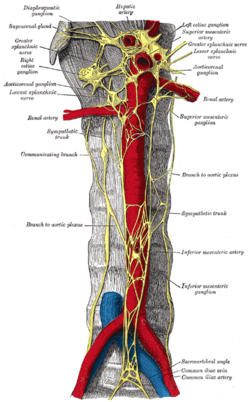Sympathetic trunks
| Sympathetic trunk | |
|---|---|

Abdominal portion of the sympathetic trunk, with the celiac plexus and hypogastric plexus. (Sympathetic trunk labeled at center left.)
|
|

Scheme showing pathways (white/grey rami are spatially reversed, possibly for clarity?) of a typical spinal nerve.
1. Somatic efferent. 2. Somatic afferent. 3,4,5. Sympathetic efferent. 6,7. Parasympathetic afferent. |
|
| Details | |
| Identifiers | |
| Latin | truncus sympathicus |
| Dorlands /Elsevier |
t_20/12826120 |
| TA | A14.3.01.002 |
| FMA | 6258 |
|
Anatomical terminology
[]
|
|
The sympathetic trunks (sympathetic chain, gangliated cord) are a paired bundle of nerve fibers that run from the base of the skull to the coccyx.
The sympathetic trunk lies just lateral to the vertebral bodies for the entire length of the vertebral column. It interacts with the anterior rami of spinal nerves by way of rami communicantes. The sympathetic trunk permits preganglionic fibers of the sympathetic nervous system to ascend to spinal levels superior to T1 and descend to spinal levels inferior to L2/3.
The superior end of it is continued upward through the carotid canal into the skull, and forms a plexus on the internal carotid artery; the inferior part travels in front of the coccyx, where it converges with the other trunk at a structure known as the ganglion impar.
Along the length of the sympathetic trunk are sympathetic ganglia known as paravertebral ganglia.
The sympathetic trunk (yellow) can be seen just lateral to the vertebral column.
The sympathetic trunk is a fundamental part of the sympathetic nervous system, and part of the autonomic nervous system. It allows nerve fibres to travel to spinal nerves that are superior and inferior to the one in which they originated. Also, a number of nerves, such as most of the splanchnic nerves, arise directly from the trunks.
...
Wikipedia
